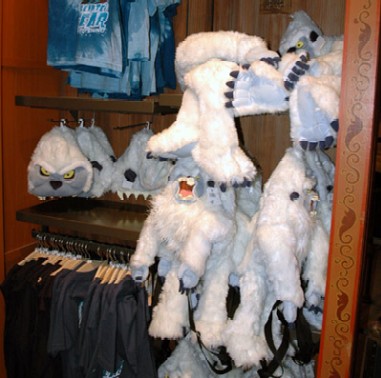
June 17, 2007
People get the craziest ideas in their heads about all of the money supposedly flowing from “selling” Bigfoot and other cryptozoological monsters. What might be the source of such thoughts? Well, that would be the general media, of course.

Take Dwain Walden, who is the editor/publisher of The Moultrie Observer, in Moultrie, Georgia. Apparently bored with the usual fare to write about, and obviously not coming up with any Father’s Day themes to his liking, this editor takes on Bigfoot.
In a column for Sunday, June 17, 2007, Walden has a giggle at the expense of the “folks of Rock Bluff” in Florida, who recently experienced a couple “leaping sturgeon” incidents that hurt some people fishing. Walden suggests (we are assuming with tongue-in-cheek) the marketing potential of these events along the Suwannee River. (Editor Walden, of course, doesn’t seem to know anything about the history of a river monster that has been seen in that area for decades.)
Walden ponders, without information, his “insights” on the historical precedents to be found in cryptozoology:
Given that sturgeons look rather prehistoric, this thing could take on “Loch Ness” proportions if properly handled, except that these things really exist, unlike “Nessie”, “Bigfoot,” and the “Abominable Snowman.”
These particular sturgeons can grow to be eight feet long and weigh 200 pounds. They have scales that resemble armor plating. They are naturally fitted for drama.
Neither of the two victims of these sturgeon had life-threatening injuries, but that could be stretched a bit for effect. Let Hollywood play with it a while, and it could become a threat surpassed only by “Jaws.”
Towns in the northwestern U.S. make fortunes selling the “Bigfoot” story. Coffee mugs, T-shirts and other stuff hawk an imaginary link between man and beast. Big things that go bump in the night will sell.
Certainly anglers could be enticed into such a marketing venture involving the sturgeon. And I say that not knowing what the rules are for fishing for sturgeon. For all I know, they may be a protected species.
Walden appears to know as much about the profit margin in Bigfoot Country as he does about the fishing regulations of sturgeon. Oh sure, you say, I have no sense of humor about this. Well, yes, I do. After all, I’ve been chasing monsters and doing cryptozoology since 1960. But I also know the power of off-hand remarks in the media like “Towns in the northwestern U.S. make fortunes selling the ‘Bigfoot’ story.”
The majority of the general public begins to believe those kinds of statements.
Walden continues on later in his article (or was it an editorial?):
Not every community has such events that can be embellished for profit. Here in Colquitt County, we have no major streams nor even any very large lakes to hide mysterious large creatures. During this recent drought, there were not that many bodies of water that could even support more than a couple of bass boats at one time. As well, we don’t have large enough wooded areas to conceal a “Bigfoot”.
So unless someone could produce a really large armadillo and claim that it uprooted his mobile home, we just don’t have that kind of “legend” potential. “A Legend Waiting to be Born,” by Dwain Walden, The Moultrie Observe, June 17, 2007.
Besides upsetting mobile home owners, does Walden have a clue about revitalizations that issue from the discovery of local history? Whether they are due to the fact Lafayette supposedly stopped by your town in 1824 or Bigfoot allegedly attacked some miners in a nearby local canyon in 1924?
Certainly, towns like Willow Creek, California (Bigfoot); Harrison Hot Springs, British Columbia (Sasquatch); Point Pleasant, West Virginia (Mothman); Sutton-Flatwoods, West Virginia (Flatwoods Monster); Dover, Massachusetts (Dover Demon); Port Henry, New York (Champ); Kelowna, British Columbia (Ogopogo); Monterey, California (Bobo); Salem, Massachusetts (Great Sea Serpent); Fouke, Arkansas (Boggy Creek Monster); Jefferson, Texas (Bigfoot); Portland, Maine (Cassie) and others are discovering their local cryptids to share with the tourists.
But “fortunes” (technically defined as “great wealth”) are not to be made off of monsters. Most of these cryptozoologically-linked spots are merely acknowledging their own histories, almost as much for the locals as for the tourist trade.
Still the potential of cryptotourism must be realized for some communities that have seen a decline of their towns, as there is a shift to the suburban malls.
Frankly, I congratulate Point Pleasant for realizing that, instead of seeing the middle of that little old river town continue to decay, they decided to celebrate the legacy of Mothman. A Bigfoot museum in town can pump new life into old villages.
Why shouldn’t the residents do a fix up, add a museum, get a statue, and say, “Hey, look at us”? Point Pleasant or Willow Creek will never be a Drumnadrochit (at Loch Ness), which I called the “Epicenter of Cryptozoology,” a few years ago. But then, if Bigfoot saves Willow Creek and Mothman does the same for Point Pleasant, despite the fact people there will not become millionaires, I’m glad to see it happen.
Hey, you know what? Generally, some people traveling to these “monster locations” actually appreciate bringing back, in time honored fashion, a souvenir. What’s wrong with that? But don’t tell me people are making “fortunes” selling keychains of Bigfoot tracks any more than the tourist locations where you can buy icebox magnets of Route 66 road signs or whiskey glasses with Devil’s Tower on the side.

Souvenirs at Disney World of the wrongly-colored Abominable Snowmen items. (Yetis are not white.) At least at most mom-and-pop owner-operated cryptotourism shops, they get their cryptozoology right.
No one tell editor Walden, but you want to know the real secret behind most of these cryptotourism locations? It’s not the money, folks (unless you are Disney with an attraction on the scale of Expedition Everest in Orlando, Florida). The fact is that the majority of these local Bigfoot and cryptid hotspots are merely just plain fun for all involved – those running them, those researchers contributing the field evidence, the people taking their families to them, and, yes, even the editors writing about them.
Happy Father’s Day, fellow fathers.
About Loren Coleman
Loren Coleman is one of the world’s leading cryptozoologists, some say “the” leading living cryptozoologist. Certainly, he is acknowledged as the current living American researcher and writer who has most popularized cryptozoology in the late 20th and early 21st centuries.
Starting his fieldwork and investigations in 1960, after traveling and trekking extensively in pursuit of cryptozoological mysteries, Coleman began writing to share his experiences in 1969. An honorary member of Ivan T. Sanderson’s Society for the Investigation of the Unexplained in the 1970s, Coleman has been bestowed with similar honorary memberships of the North Idaho College Cryptozoology Club in 1983, and in subsequent years, that of the British Columbia Scientific Cryptozoology Club, CryptoSafari International, and other international organizations. He was also a Life Member and Benefactor of the International Society of Cryptozoology (now-defunct).
Loren Coleman’s daily blog, as a member of the Cryptomundo Team, served as an ongoing avenue of communication for the ever-growing body of cryptozoo news from 2005 through 2013. He returned as an infrequent contributor beginning Halloween week of 2015.
Coleman is the founder in 2003, and current director of the International Cryptozoology Museum in Portland, Maine.
Filed under Bigfoot, Breaking News, Cryptomundo Exclusive, Cryptotourism, CryptoZoo News, Cryptozoologists, Cryptozoology, Dover Demon, Lake Monsters, Loch Ness Monster, Mothman, Museums, Ogopogo, Pop Culture, Sasquatch, Sea Serpents, Yeti